|
|
|
snorkeling in Sullivan Bay
Sunday, January 30 2005
setting: Sullivan Bay, Santiago Island, Galapagos, Ecuador
We spent the morning in the Galapago's most famous landscape, Sullivan Bay. You've surely scene it in posters and promotional literature. Its major geologic feature sticks up from a small offshore island called Bartolomé. It's a tall rock that seems to lean slightly out over the water. This rock is the sole remnant of an ancient lava flow that has been largely eroded away or buried beneath far more recent flows. Most of the landscape around Sullivan Bay looks like it was created by recent lava flows, but when I asked our guide Cezar what the age of the rock was, he said what he always says when asked this question (no matter where in the Galapagos you happen to be), "Five meeyun years." That's about the age of the oldest rock in the Galapagos.
Our first activity today was to do a dry landing on Bartolomé and then climb up a series of wooden steps to the top of a steep, barren lava hill. It's from the top of this hill that all the famous pictures of Sullivan Bay have been taken. On the way up we passed through a landscape not too different from the Moon. The rock was so new that there hadn't been time for plants to get a toehold. From the lookout at the top we could see a variety of flows of different ages. Though he'd been consistently using the "five meeyun" figure, Cezar did have a more recent figure for one of these flows, which had happened only a hundred years ago.
There were a lot of tourists making use of the Sullivan Bay lookout. According to Cezar, Sullivan Bay is a major destination for visitors who are only out on day cruises. In the Galapagos a day cruise is a particularly inefficient use of financial resources, since even if you come for only a day, you still have to pay the $100 tourist fee and whatever hundreds of dollars the airline flight costs.
On the way back down the slope, the youngest of the Australians asked Gretchen what she thought about George W. Bush. Gretchen had been pretty outspoken politically, but somehow this particular Australian (who hadn't generally sat at our dining table) hadn't heard. "I feel like throwing up," Gretchen said. Then she told about our experience the day after the election, when we'd lain in bed and held onto each other in misery.
After landing on the sharply curving beach near the massive leaning rock, some of us crossed a sandy isthumus to a second beach whose curve was a mirror image of the one where we'd landed. While the beach where we'd landed was full of human swimmers, snorkelers, and sunbathers, nobody was at the other beach. This is because people aren't allowed to swim here. It's reserved for the Black Tip Sharks, who like to scratch themselves in the sand in the slightly warmer water of this beach. Bending the rules a bit (Cezar is pretty laid back about such things), we waded out a little ways and were only a couple yards from the sharks, which were each five or six feet long.
Back at the swimming beach, we all went snorkeling among the submarine lava flows. As always, it was a mind-blowing experience. It it even possible to get tired of snorkeling? I felt like I was becoming a master of my equipment, because now I'd figured out how to handle water when it came down my snorkel. I just blew it out with a determined puff. Now my only problem was what to do about water in my snorkel on the occasions when I had no air left in my lungs.
Now that I was comfortable with my equipment, I would do things I would have never even considered before, like diving far beneath the surface and not worrying about whether or not my snorkel took on water. My biggest problem now was a temporary one: my head cold. Whenever I dived to the bottom the immense pressure of the water aggravate a mild ache in my right ear. It felt like a nail was being driven into my ear drum.
At some point some of the Golondrina folks went off to go scuba diving. Gretchen decided to join them for her first-ever dive. While they were doing that, I was snorkeling around the base of the massive leaning rock of Sullivan Bay. There were a great many sea lions there, and (as always) they seemed very curious as they swam past me at high speed. With my flippers and snorkel I felt like such a poser in their world. For some reason, though, the sea lions were charitable in their mocking.
There were a few Galapagos Penguins swimming in the water and one even sunning itself on a rock. In the water they were as agile as (and occasionally difficult to distinguish from) fish. The presence of penguins might leave you wondering about the temperature of the water. The Galapagos are as far north as penguins go, and though ocean water here might be cold by tropical standards, it's not too cold for swimming. Water currents come from colder places in the Southern Hemisphere, but January is the warm season in the Galapagos. I found the ocean water much warmer than I remember it being in southern California but still colder than, say, at Coney Island in the summer. After swimming in it for awhile you eventually feel like your body is losing its heat, but this takes awhile.
By late afternoon the Golondrina was back along the coast of Santa Cruz Island. We dropped anchor and landed on something called Bachas Beach. The name dates back to World War II, when the American navy abandoned a couple barges on this beach. The locals, unable to pronounce "barges," used the word "bachas" instead. We got a chance to see the rusty remains of one of the barges protruding from the sand. What remained was about as long as a schoolbus but only two feet high and eight feet wide. Cezar told us that the remains had been much larger 25 years ago.
There wasn't all that much to see on the Bachas Beach, but not far inland we were surprised to come upon a saltwater lagoon full of pink flamingos. As with the lagoon at Floreana, the air around the Bachas Beach lagoon was home to more than a few persistent green-eyed Galapagos horse flies.
By the time we returned to the Golondrina I was feeling very weak, so I retreated to the cabin and stayed there for the rest of the night. I had Gretchen bring me dinner, and despite how bad I felt I was ravenous. Vegetarian options were not enough so I had Gretchen get me chicken.
Unable to read or write, I decided to watch a DVD on my iBook. Gretchen had put together a small collection of DVDs, most of them in Spanish. I picked one of the few in English, The Station Agent, which I'd seen before and wanted to see again.
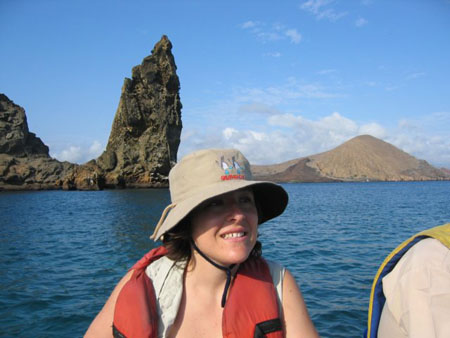
Gretchen with the famous rock.
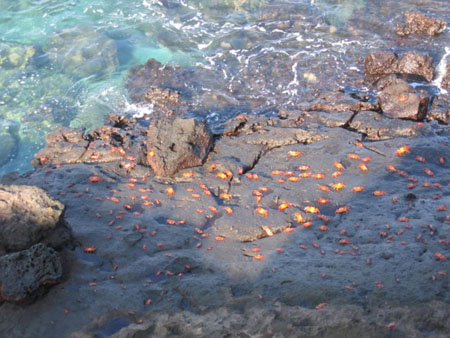
Sally Lightfoot Crabs in the Bartolomé surf.
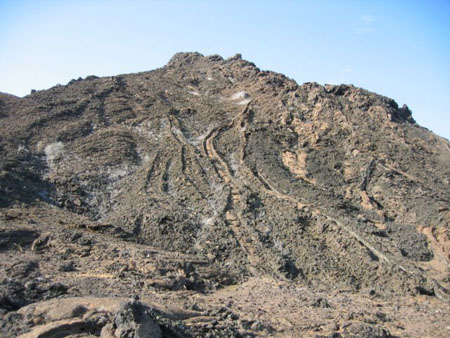
Ropey lava.
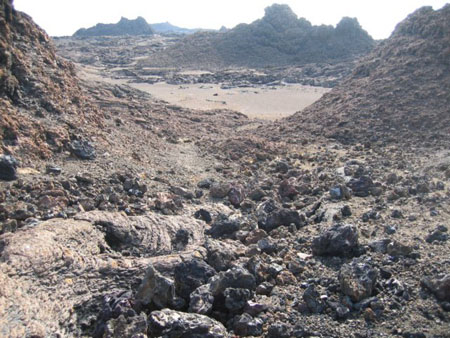
A moonlike landscape on the way up to the Sullivan Bay lookout.
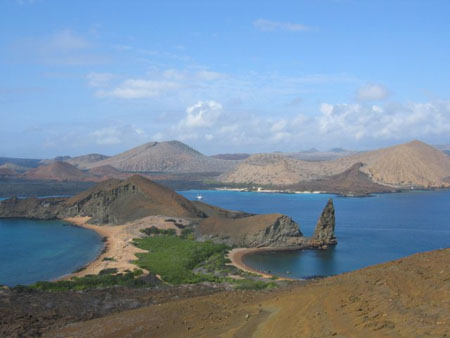
The classic postcard picture.
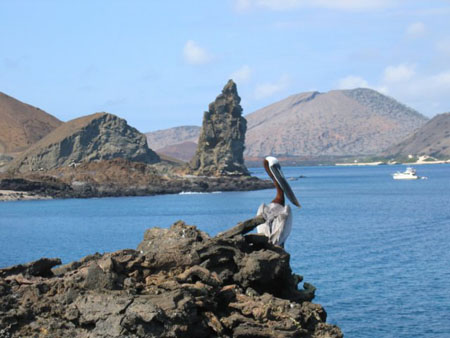
A pelican at Sullivan Bay.
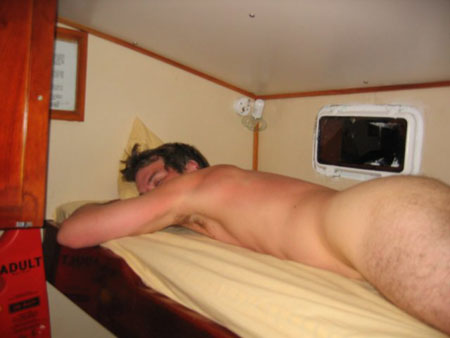
That's me being naked and feeling sick.
For linking purposes this article's URL is:
http://asecular.com/blog.php?050130 feedback
previous | next |






